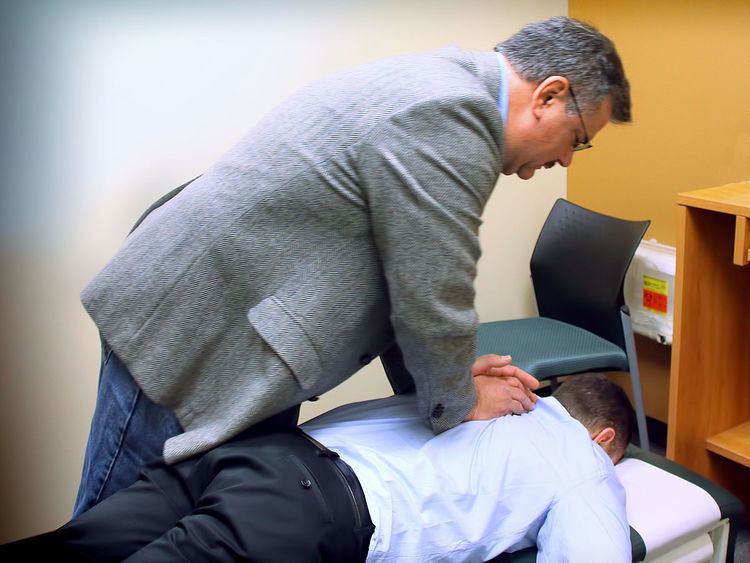 | ||
Spinal adjustment and chiropractic adjustment are terms used by chiropractors to describe their approaches to spinal manipulation, as well as some osteopaths, who use the term adjustment.
Contents
- Adjustmentmanipulation
- Defined as unique to chiropractic
- Intention to correct vertebral subluxations
- Adjustment methods
- Techniques
- Effects
- Safety
- References
Spinal adjustments were among many chiropractic techniques invented in the 19th century by Daniel David Palmer, the founder of Chiropractic. Claims made for the benefits of spinal adjustments range from temporary, palliative (pain relieving) effects to long term wellness and preventive care. Despite anecdotal success, there is not yet scientific evidence that spinal adjustment is effective against disease.
Adjustment/manipulation
In a section titled "Spinal Manipulation: The Chiropractic Adjustment", chiropractic authors and researchers Meeker and Haldeman write that the core clinical method that all chiropractors agree upon is spinal manipulation, although chiropractors much prefer to use the term spinal "adjustment", a term which reflects "their belief in the therapeutic and health-enhancing effect of correcting spinal joint abnormalities." (p. 218)
Defined as unique to chiropractic
The International Chiropractor's Association (ICA) states that the "chiropractic spinal adjustment is unique and singular to the chiropractic profession", and that it "is characterized by a specific thrust applied to the vertebra utilizing parts of the vertebra and contiguous structures as levers to directionally correct articular malposition. Adjustment shall be differentiated from spinal manipulation in that the adjustment can only be applied to a vertebral malposition with the express intent to improve or correct the subluxation, whereas any joint, subluxated or not, may be manipulated to mobilize the joint or to put the joint through its range of motion... Chiropractic is a specialized field in the healing arts, and by prior rights, the spinal adjustment is distinct and singular to the chiropractic profession." One author claims that this concept is now repudiated by mainstream chiropractic. The definition of this procedure describes the use of a load (force) to specific body tissues with therapeutic intent. This ‘load’ is traditionally supplied by hand, and can vary in its velocity, amplitude, duration, frequency, and body location (p. 218) and is usually abbreviated HVLA (high velocity low amplitude) thrust.
Intention: to correct vertebral subluxations
The intention of a chiropractic adjustment is to affect or correct the alignment, motion and/or function of a vertebral joint. Specifically, they are intended to correct "vertebral subluxations", the term given to the signs and symptoms that are said by chiropractors to result from abnormal alignment of vertebrae. (p. 218) This intention forms the legal and philosophical foundation of the profession, and US Medicare law formulates it in this manner:
"Coverage of chiropractic services is specifically limited to manual manipulation of the spine to correct a subluxation... Medicare will not pay for treatment unless it is 'manual manipulation of the spine to correct a subluxation'."Adjustment methods
As the chiropractic profession grew, individual practitioners and institutions proposed and developed various proprietary techniques and methods. While many of these techniques did not endure, hundreds of different approaches remain in chiropractic practice today. Not all of them involve HVLA thrust manipulation. Most cite case studies, anecdotal evidence, and patient testimonials as evidence for effectiveness. These techniques include:
Techniques
There are many techniques which chiropractors can specialize in and employ in spinal adjustments. Some of the most notable techniques include:
Over the years, many variations of these techniques have been delivered, most as proprietary techniques developed by individual practitioners. WebMD has made a partial list:
Effects
The effects of spinal adjustment vary depending on the method performed. All techniques claim effects similar to other manual therapies, ranging from decreased muscle tension to reduced stress. Studies show that most patients go to chiropractors for musculoskeletal problems: 60% with low back pain, and the rest with head, neck and extremity symptoms. (p. 219) Also the article "Chiropractic: A Profession at the Crossroads of Mainstream and Alternative Medicine" states that, “chiropractic was to be a revolutionary system of healing based on the premise that neurologic dysfunction caused by ‘impinged’ nerves at the spinal level was the cause of most dis-ease”. (p. 218) The mechanisms that are claimed to alter nervous system function and affect overall health are seen as speculative in nature, however, clinical trials have been conducted that include “placebo-controlled comparisons [and] comparisons with other treatments”. (p. 220) The American Chiropractic Association promotes chiropractic care of infants and children under the theory that “poor posture and physical injury, including birth trauma, may be common primary causes of illness in children and can have a direct and significant impact not only on spinal mechanics, but on other bodily functions”.
The effects of spinal manipulation have been shown to include: temporary relief of musculoskeletal pain, increased range of joint motion, changes in facet joint kinematics, increased pain tolerance and increased muscle strength. (p. 222) Common side effects of spinal manipulative therapy (SMT) are characterized as mild to moderate and may include: local discomfort, headache, tiredness, or radiating discomfort. (p. 222)
Safety
There is not sufficient data to establish the safety of spinal manipulations. The rate of adverse events is unknown. Adverse events are increasingly reported in randomized clinical trials of spinal manipulation but remain under–reported despite recommendations in the 2010 CONSORT guidelines. It is frequently associated with mild to moderate temporary adverse effects, and also serious outcomes which can result in permanent disability or death, which include strokes, spinal disc herniation, vertebral and rib fractures and cauda equina syndrome. Serious outcomes are likely rare. About half of people reported encountering adverse effects following spinal manipulation.
